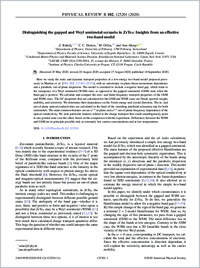Distinguishing the gapped and Weyl semimetal scenario in $\mathrm{Zr}{\mathrm{Te}}_{5}$: Insights from an effective two-band model
- Rukelj, Z. Department of Physics, University of Fribourg, 1700 Fribourg, Switzerland - Department of Physics, Faculty of Science, University of Zagreb, Bijeniˇcka c. 32, 10000 Zagreb, Croatia
- Homes, C. C. Condensed Matter Physics and Materials Science Division, Brookhaven National Laboratory, Upton, New York 11973, USA
- Orlita, M. LNCMI, CNRS-UGA-UPS-INSA, 25, avenue des Martyrs, F-38042 Grenoble, France - Institute of Physics, Charles University in Prague, CZ-12116 Prague, Czech Republic
- Akrap, Ana Department of Physics, University of Fribourg, 1700 Fribourg, Switzerland
-
10.09.2020
Published in:
- Physical Review B. - 2020, vol. 102, no. 12, p. 125201
English
Here we study the static and dynamic transport properties of a low-energy two-band model proposed previously in Martino et al. [PRL 122, 217402 (2019)], with an anisotropic in-plane linear momentum dependence and a parabolic out-of-plane dispersion. The model is extended to include a negative band gap, which leads to the emergence of a Weyl semimetal (WSM) state, as opposed to the gapped semimetal (GSM) state when the band gap is positive. We calculate and compare the zero- and finite-frequency transport properties of the GSM and WSM cases. The DC properties that are calculated for the GSM and WSM cases are Drude spectral weight, mobility, and resistivity. We determine their dependence on the Fermi energy and crystal direction. The in- and out-of-plane optical conductivities are calculated in the limit of the vanishing interband relaxation rate for both semimetals. The main common features are an ω1/2 in-plane and ω3/2 out-of-plane frequency dependence of the optical conductivity. We seek particular features related to the charge transport that could unambiguously point to one ground state over the other, based on the comparison with the experiment. Differences between the WSM and GSM are in principle possible only at extremely low carrier concentrations and at low temperatures.
- Faculty
- Faculté des sciences et de médecine
- Department
- Département de Physique
- Language
-
- English
- Classification
- Physics
- License
-
License undefined
- Identifiers
-
- RERO DOC 329490
- DOI 10.1103/PhysRevB.102.125201
- Persistent URL
- https://folia.unifr.ch/unifr/documents/308996
Statistics
Document views: 161
File downloads:
- pdf: 191
